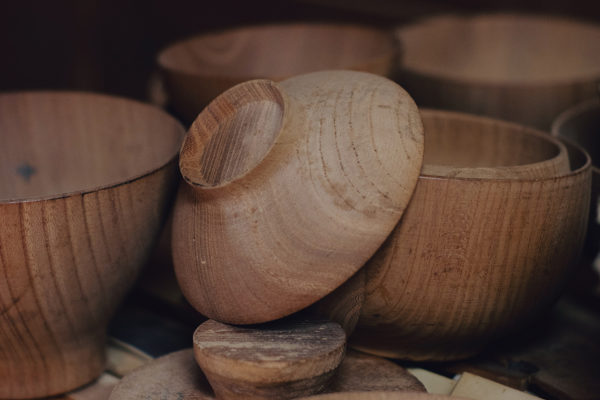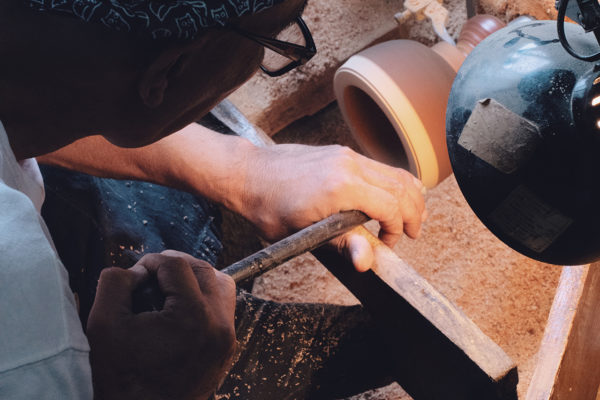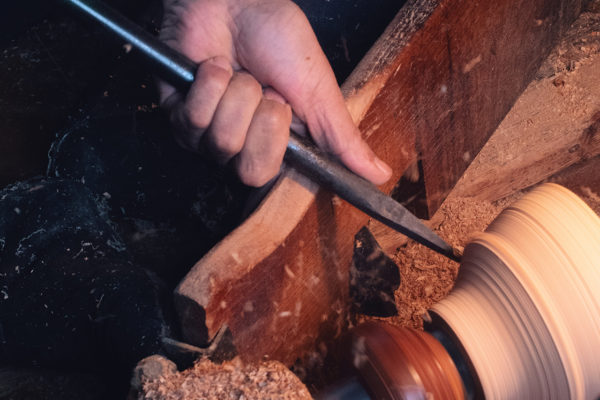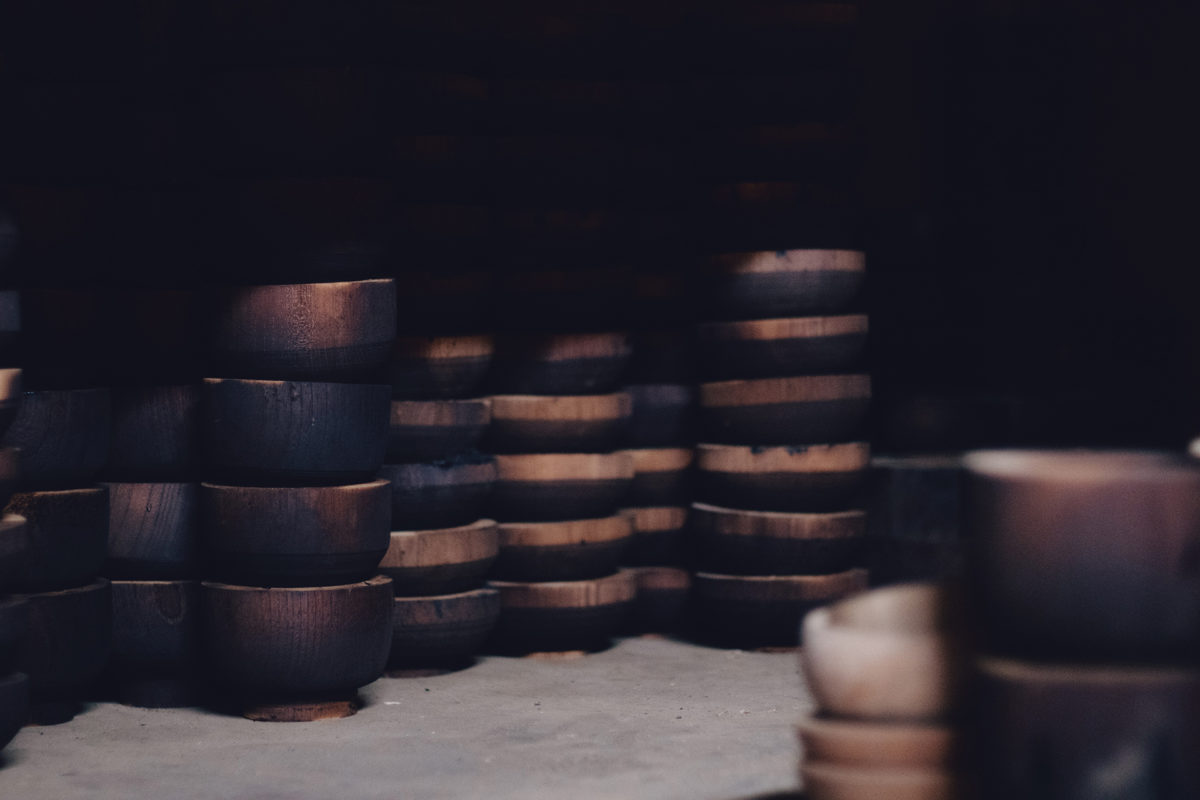ARTICLES
Wankiji
This technique is for making circular vessels, such as bowls. Also called hikimonokiji (meaning “turned wood”), as the name suggests, the kiji is turned (hiki) by hand on a lathe by the kijishi using a variety of cutting tools. The kijishi relies on the sound of the wood being turned and the vibrations and sensations transmitted to their hands to create a beautiful, flawless circle. In addition to bowls, it is mainly used to craft confectionery dishes, tea cup saucers, and round trays, etc.
Process Overview

1 Katahatsuri
Lumber such as zelkova, horse chestnut, cherry birch, or chestnut is cut into rounds based on a pattern, which are then roughly cut down using a hatchet or other tool into an aragata (meaning “rough shape”), which will be the base for the kiji.

2 Kunenkanso
The aragata is smoked and dried for about a month using the smoke from burning sawdust, etc. Afterward, it is allowed to further dry naturally in a storehouse for a few months, up to as long as 6 months to a year, to adjust the water content. This stops flaws from developing in the shape of the kiji, while also preventing it from splitting after it is completed.

3 Arahiki
The aragata is turned on the lathe and cut down to a smaller size rather than finished, then allowed to dry again.

4 Kijihiki
The outside of the workpiece is turned down on a lathe using cutting tools (sotohiki) while the depth and shape of the bowl is measured with handmade guides. Next, the inside of the bowl is turned (uchihiki) while the depth is measured with a guide called a tsukkomi. Finally, the bottom rim (the ring shape on the bottom of the bowl) is turned to complete the bowl.

[Distinctive Techniques]
Kunenkanso……A technique in which the sawdust created by turning the kiji is burned to smoke and dry the aragata. To prevent splitting of the wood from rapid drying, moisture is slowly drawn from the exterior of the kiji over about a month, until the water content finally approaches zero. Afterward, the aragata is moved to a special room kept at the proper humidity, and it is allowed to absorb moisture from the air over a long period of time. Here the water content is raised to 11-13%, achieving the optimal amount of moisture for wankiji.
Hiki……A technique in which the artisan uses handmade cutting tools to finish aragata (the base form for kiji) with varying wood grain and hardness into objects with beautiful curves. The artisan measures the diameter and depth, etc., of the bowl using guides, ultimately finishing it using their skill and sensibility.
[Tools]
Lathe, cutting tools, polishing stones, guides for curves and depth, etc.

[Features and Use of Techniques]
The curved lines and surfaces created by the technique of hiki, the pinnacle of the wankijishi’s art, are so smooth and beautiful it is said that not even machines can replicate them.
“The most difficult part is creating curves. Therefore, I use different gauges and guides for measuring the diameter and so on while I cut. I cut a little, and if it seems off, I cut more, and repeat the process. Obviously, there are aspects where I rely on my senses, that is to say, a kind of intuition that comes with experience. But you can’t cut by intuition alone. That’s because human senses aren’t always reliable.”
These are the words of the wankijishi (maker of wankiji) Shigeru Kancho. Though he is a veteran with 50 years in this line of work, even he is painstaking when turning.
“I make the gauges and guides I use for cutting myself. My cutting tools are also handmade, and in my case, I usually use six tools to turn a bowl. While different types are used depending on the part being turned, the cutting edges all use high speed steel (a special type of steel used in tools for cutting metal at high speeds). They’re more resistant to dulling than ordinary steel edges, so they’re easy to use, and they can also handle hard materials.”
Speaking of hard materials, he also touched on the current lumber situation.
“These days, the material is getting worse and worse, and there’s more and more hard material we never would’ve used in the old days. On top of that, even that hard wood isn’t readily available on the market. That’s because there are fewer workers who cut lumber from the mountains, but we can’t get anything done if there’s no wood coming down from the mountains, so this is a major problem. The kiji is usually kept for six months to a year before turning, but the material itself is so scarce these days, we can’t keep it in storage that long. Inevitably, our stocks shrink, and under the current circumstances, we’re forced to use the hard wood.”
The world of traditional handicrafts suffers from a chronic shortage of successors, but it would be fair to say that the workers who cut the lumber used for raw material receive no attention at all. His words reinforce the significance of this.
Even though he is past 70, he is still full of energy. Despite his apprehensions about the current situation, he continues moving forward, taking on new challenges with passionate intensity.
“I made this spoon as an experiment. The rounded end called the bowl is finished in quarters, which gives it beautiful lines. The feel of withdrawing the spoon from your mouth is very important. I create that pleasant feeling using woodturning techniques.”
In addition to this, he has also made his own circular bracelets and other items, rooted in an insatiable desire “to create new things using curved lines.” Therefore, he is always searching for things that can be combined with circular objects to create “something only a wankijishi can make.” In the end, he had this to add.
“For example, there is a trend among high class restaurants and the like preferring bowls that are turned very thin, and I think I might have ones of just the right thickness.”
Focusing on the thickness of the wood seems to have given him a clue toward yet another a new application.
